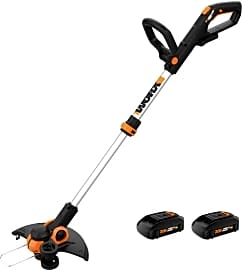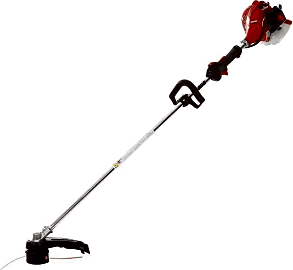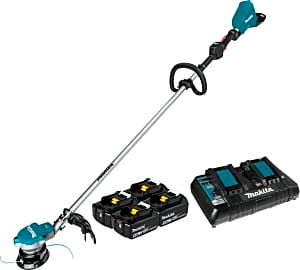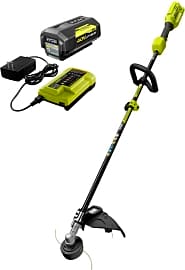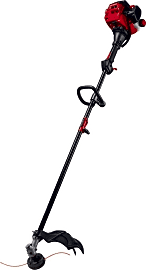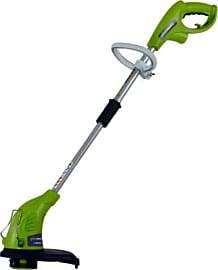The 10 Best String Trimmers

This wiki has been updated 41 times since it was first published in March of 2015. If you're looking to tidy up your lawn without having to resort to heavy equipment, try one of these string trimmers. They can get close to fences, flower beds, and walkways without damaging them. These weed whackers are suitable for maintaining many sizes of yards, and they come in gas and electric options with enough power for everything from tiny gardens to professional landscaping jobs. When users buy our independently chosen editorial recommendations, we may earn commissions to help fund the Wiki.
Editor's Notes
December 03, 2020:
We've made quite a few changes during this update, as the competitive world of string trimmers sees multiple new models arrive every year. We've replaced two older items with their newer, better versions - the Ego Power Plus ST1521S and the Worx WG163 2-in-1, both of which continue to rate highly. We've also added the Ryobi Expand-It Cordless, which can be used with a variety of attachments, and the Dewalt Flexvolt DCST970X1, a professional-grade machine for heavy-duty jobs.
The Makita XRU15PT1 is a good middle-of-the-road option, with three speeds for greater control. Another newcomer is the Echo SRM-225 Straight, which has several user-friendly features to make your work a little easier. We've also added a new listing under Special Honors from one of the top brands in the game.
We've removed the Black and Decker 3-in-1 because its mower function received not-so-great reviews, and the Remington RM1159 because its price grew higher as its ratings fell. The Husqvarna HU625HWT is no longer available. Finally, we've updated the information on several items, including the Husqvarna 324L, the Greenworks 21212, and the Craftsman WeedWacker.
April 13, 2019:
With the proliferation of highly efficient battery technology, there are more varieties of landscaping tools available than ever before. Depending on the size of your yard and the type of grass and brush it's populated with, you can get by with a light- or heavy-duty battery-powered model, though more extensive jobs or rural areas may still call for a gas-powered device. Small yards may be well served by the Black and Decker 3-in-1 or the Worx WG162. Worx's trimmers offer a pair of incredibly helpful wheels that stabilize the device and keep the lines straight. Their WG180 is set up similarly, though it has considerably more power, as well as an adjustable guard around the trimming mechanism to protect flowers, bushes, trees, and other sensitive objects in and around your lawn and garden. The GreenWorks and Black and Decker LST136 are additional light-duty models that don't make a lot of noise or spit out smelly exhaust. But if you have considerable material to trim, consider the Ego Power+, considered by quite a few hands-on reviewers to be the best of the bunch. It offers a great balance of cutting power and portability.
If you decide that you do need a more traditionally fueled unit, the Craftsman is an excellent choice, though you will have to mix up the proper gas and oil for its 2-cycle engine. To skip that step, consider the Husqvarna, which actually uses a 4-cycle engine, and as such runs on pure gasoline. It's quite expensive, however. Finally, for considerably larger tasks, Husqvarna and Remington both offer rolling models that are slightly similar in design to a standard lawnmower, though of course they're overkill for the average residential yard.
Special Honors
Stihl FS91R Well-balanced and comfortable to hold, this high-quality, gas-powered unit is great for large properties and professional work. Its 28.4cc, 4-stroke engine requires no premixed fuel and offers reduced emissions, noise, and weight when compared to a 2-stroke model. stihlusa.com
How To Choose The Right String Trimmer
The larger your landscape to maintain and the thicker the brush, the more powerful of a string trimmer you should buy.
String trimmers come in a range of sizes, and with a variety of attachments, so it can be difficult for some to identify which one is right for their needs. One of the first decisions to make is whether a gas-powered or electric model is best for you. As a general rule of thumb, gas-powered models will be more powerful and can run for longer, but they are also louder and may be more difficult to start. Gas-powered models are a good choice if you have thick brush to cut or a large area that must be maintained.
Electric models come in two varieties, battery-powered and corded models. With a corded model you never have to worry about running out of juice mid-way through your yard, but being connected means your range is limited. Even with long extension cords, they can sometimes be difficult to manage, especially over terrain with obstacles. The extra mobility of battery-powered models can be helpful and many of the newer models with 40 to 80V lithium-ion batteries are just as powerful as the corded models. Whichever type of electric model you choose, they will both be easy to start at the push of a button, noticeably quieter than a gas-powered model, and more eco-friendly.
The larger your landscape to maintain and the thicker the brush, the more powerful of a string trimmer you should buy. Otherwise, it may have difficulty taking on the task at hand. Thick weeds can get tangled up in the strings of less powerful models instead of being cut. If you are just cutting grass and some minor weeds, a light-duty model with a smaller engine should be fine. If you are working on more than an acre or two of land or trying to hack through some thick sections of weed, your best bet is a medium to heavy-duty trimmer.
Whichever kind and size you choose, it is often preferable to buy one that either accepts or, more preferably, comes with attachments that allow you to easily perform other tasks, like edging or leaf blowing, without buying a dedicated tool.
Tips For Using A String Trimmer
One of the most important tips for using a string trimmer is to buy the right size string. If your string is too small, it may not cut thick weeds effectively, and if it is too large, you may not be able to wrap enough of it around the spool, resulting in you having to stop and add more string too often.
A string trimmer can also be used for edging by holding it at a vertical orientation to the ground as opposed to vertical.
To avoid completely stripping a yard bald, it is imperative that you hold a string trimmer level and a couple of inches off of the ground. Once you have it held comfortably level, roughly three inches above the ground, make wide, side-to-side sweeping motions while keeping it parallel to the ground the whole time. It may take some practice to get it right, so start on a part of your lawn that isn't seen often.
If trimming overly tall weeds, it is best to start from the top and work your way down. Oftentimes the string can get tangled in the stems if you start on tall weeds from the bottom. Instead, just cut off a few inches in each pass and work your way down to your desired cut height.
A string trimmer can also be used for edging by holding it at a vertical orientation to the ground as opposed to vertical. It is easier to just use a dedicated edger, but for those who don't have the cash to lay out on an edger, a string trimmer works in a pinch.
Always wear long pants, closed-toed shoes, and eye protection when using a string trimmer. It is not uncommon for small rocks to fly off the ground and potentially cause injury if one is not wearing the proper safety gear.
The Inventor Of The String Trimmer
The first string trimmer was invented by Tim West in the late 1960s. He built it out of a handheld router with a chain bolted to the center spindle, which was then mounted to a pole. For some reason or another he never tried patenting or marketing his idea, so the notable inventor of the string trimmer was George Ballas.
For some reason or another he never tried patenting or marketing his idea, so the notable inventor of the string trimmer was George Ballas.
In the early 1970s, he conceived the idea while getting his car washed. He was watching the revolving action of the cleaning brushes, which inspired him to make a revolving grass and weed cutter. He built his first string trimmer out of a popcorn can, an edger, and heavy-duty wire fishing line.
He decided to consult with a mechanical engineer by the name of Thomas N. Geist to make an improved version that could be sold commercially. He patented his string trimmer in 1974. He called his invention the weed eater and by 1977 he had made millions in sales. Ballas went on to patent other inventions, such as a rotary string lawn mower and an adjustable table for hospital beds.
All modern string trimmers utilize Ballas' same design. They have a long shaft with an engine on the top for balance and a cutter head at the bottom. As with his first commercial model, nearly every one has a protective guard of some kind to cover the string and reduce the amount of debris that flies up towards the user.


